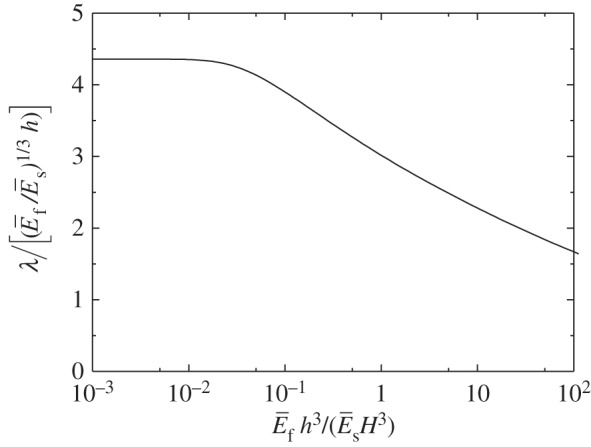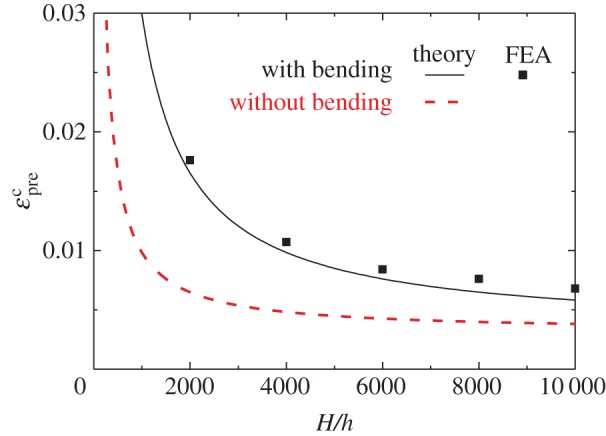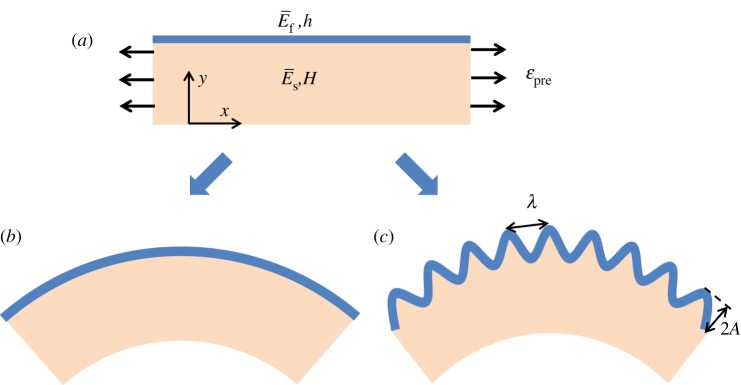Abstract
A stiff thin film bonded to a pre-strained, compliant substrate wrinkles into a sinusoidal form upon release of the pre-strain. Many analytical models developed for the critical pre-strain for wrinkling assume that the substrate is semi-infinite. This critical pre-strain is actually much smaller than that for a substrate with finite thickness (Ma Y et al. 2016 Adv. Funct. Mater. (doi:10.1002/adfm.201600713)). An analytical solution of the critical pre-strain for a system of a stiff film bonded to a pre-strained, finite-thickness, compliant substrate is obtained, and it agrees well with the finite-element analysis. The finite-thickness effect is significant when the substrate tensile stiffness cannot overwhelm the film tensile stiffness.
Keywords: wrinkles, finite thickness, stiff thin film, compliant substrate, pre-strain
1. Introduction
A stiff film bonded to a pre-strained, compliant substrate wrinkles upon releasing the pre-strain [1,2]. Such a system has many important applications in stretchable inorganic electronics [3–8], micro/nano pattern formation [9–11], high-precision micro/nano measurement techniques [12], tuneable metamaterials [13], nanocomposites [14], stretchable transistors [15] and biomimetic materials [16]. Analytical models have been developed for wrinkling of a stiff thin film on a pre-strained compliant substrate [17–21]. The results identify the critical pre-strain for wrinkling, below which the film remains flat. However, all of these studies assume that the substrate is semi-infinite such that its tensile stiffness overwhelms that of the film. Consequently, the substrate recovers the initial length after the pre-strain is released and its bottom remains flat.1
The critical pre-strain for wrinkling obtained for a semi-infinite substrate, however, is smaller than the numerical and experimental results for a substrate with finite thickness [22], even for substrates that are more than 1000 times thicker than the film. This is because the substrate elastic modulus Es is often more than five orders of magnitude smaller than the film elastic modulus Ef [1,2], such that the substrate tensile stiffness EsH cannot overwhelm the film tensile stiffness Efh, where H and h are the substrate and film thicknesses, respectively (figure 1a). Consequently,
(1) the substrate cannot shrink back to its initial length after release of the pre-strain; and
(2) the film/substrate system may bend after the pre-strain is released (figure 1b).
Figure 1.
Schematic illustrations. (a) A stiff thin film bonded to a pre-strained, compliant substrate with finite thickness; (b) bending of the film/substrate system upon release of the small pre-strain; and (c) wrinkling of the stiff thin film, along with bending of the film/substrate system, upon release of large pre-strain. (Online version in colour.)
The recent study by Ma et al. [22] accounted for (1), while this paper aims to establish an analytic model for both (1) and (2). The resulting critical pre-strain will be useful for many applications such as the strain-limiting design of materials [22] and tuneable optical design of the intensity for diffraction peaks [23].
2. Analytical model
A stiff thin film is bonded onto a pre-strained (εpre), compliant substrate (figure 1a). For small pre-strain, the stiff film does not wrinkle upon release of the pre-strain; instead, the film and substrate bend (figure 1b). Let ε denote the membrane strain in the film. The strain in the substrate is εs(y)=εpre+ε−κ(H−y), where κ is the curvature of the substrate, and the co-ordinate y is shown in figure 1a. The potential energy is
| 2.1 |
where and are the plane-strain moduli of the stiff thin film and compliant substrate, respectively, and vf and vs are the Poisson’s ratios.
Minimization of the potential energy ∂Ubend/∂ε=0 and ∂Ubend/∂κ=0 gives and . Equation (2.1) then becomes
| 2.2 |
Once the pre-strain exceeds the critical pre-strain (to be determined), the stiff film wrinkles on the top surface of the substrate (figure 1c) and the film/substrate bends. In addition to the membrane strain ε, the film is also subjected to wrinkling with amplitude A and period λ to be determined. The strain energy in the film is [24]
| 2.3 |
which degenerates to the first term on the right-hand side of equation (2.1) when the amplitude A=0; here k=2π/λ. The strain energy in the substrate is
| 2.4 |
which degenerates to the last term in equation (2.1) when the amplitude A=0. The last term in the above equation is the strain energy in the substrate due to wrinkling [24], and the function g is
| 2.5 |
for an incompressible substrate (vs=0.5), and g approaches 1/2 for a semi-infinite substrate. The potential energy is the sum of Ufilm and Usubstrate,
| 2.6 |
where
| 2.7 |
Minimization of the potential energy with respect to k and A, ∂Ubend+wrinkle/∂k=0 and ∂Ubend+wrinkle/∂A=0, gives
| 2.8 |
and
| 2.9 |
where g′(x)=dg(x)/dx. Equation (2.8) suggests that the normalized period, , or equivalently , depends only on the film/substrate bending stiffness ratio , as shown in figure 2. The period becomes independent of the substrate thickness H when the bending stiffness ratio is less than 0.01, which is consistent with Huang et al. [24].
Figure 2.

The normalized wrinkle period versus the film-to-substrate bending stiffness ratio .
Minimization of the potential energy with respect to ε and κ, ∂Ubend+wrinkle/∂ε=0 and ∂Ubend+wrinkle/∂κ=0, gives , and , where f is obtained from equation (2.7). The potential energy then becomes
| 2.10 |
Comparison of the potential energy in equations (2.2) and (2.10) suggests that wrinkling occurs when Ubend>Ubend+wrinkle, which gives
| 2.11 |
where k, f and g are obtained from equations (2.5), (2.7) and (2.8), respectively. It should be pointed out that equation (2.11) also ensures that the right-hand side of equation (2.9) is positive such that there is a solution for the amplitude A.
3. Discussion
When the bending stiffness of the substrate overwhelms that of the film, i.e. , equation (2.11) can be further simplified as
| 3.1 |
For , the above equation degenerates to that for a semi-infinite substrate [1,2]. The critical pre-strain εcpre in equation (3.1) is larger than [22], which neglects the effect of film/substrate bending. Figure 3 shows the critical pre-strain εcpre versus the thickness ratio H/h for a polyimide film (Ef=2.5 GPa, vf=0.34) on a polydimethylsiloxane substrate (Es=1 MPa, vs=0.5). The results obtained from finite-element analysis agree well with the critical pre-strain in equation (3.1).
Figure 3.

The critical pre-strain εcpre versus the substrate-to-film thickness ratio (H/h) for a polyimide film on a PDMS substrate. FEA, finite-element analysis; PDMS, polydimethylsiloxane. (Online version in colour.)
Footnotes
Huang et al.[24] studied the finite thickness of a substrate subjected to compression, to be discussed below.
Competing interests
We declare we have no competing interests.
Funding
Y.M. and X.F. acknowledge support from the National Basic Research Program of China (grant no. 2015CB351900) and the National Natural Science Foundation of China (grant nos. 11402135, 11320101001). Y.X. gratefully acknowledges support from the Ryan Fellowship and the Northwestern University International Institute for Nanotechnology. Y. H. acknowledges support from NSF (DMR-1121262, CMMI-1300846 and CMMI-1400169) and the NIH (grant no. R01EB019337).
References
- 1.Bowden N, Brittain S, Evans AG, Hutchinson JW, Whitesides GM. 1998. Spontaneous formation of ordered structures in thin films of metals supported on an elastomeric polymer. Nature 393, 146–149. (doi:10.1038/30193) [Google Scholar]
- 2.Khang DY, Jiang HQ, Huang Y, Rogers JA. 2006. A stretchable form of single-crystal silicon for high-performance electronics on rubber substrates. Science 311, 208–212. (doi:10.1126/science.1121401) [DOI] [PubMed] [Google Scholar]
- 3.Ko HC. et al. 2009. Curvilinear electronics formed using silicon membrane circuits and elastomeric transfer elements. Small 5, 2703–2709. (doi:10.1002/smll.200900934) [DOI] [PubMed] [Google Scholar]
- 4.Sun YG, Kumar V, Adesida I, Rogers JA. 2006. Buckled and wavy ribbons of GaAs for high-performance electronics on elastomeric substrates. Adv. Mater. 18, 2857–2862. (doi:10.1002/adma.200600646) [Google Scholar]
- 5.Sun YG, Choi WM, Jiang HQ, Huang YGY, Rogers JA. 2006. Controlled buckling of semiconductor nanoribbons for stretchable electronics. Nat. Nanotechnol. 1, 201–207. (doi:10.1038/nnano.2006.131) [DOI] [PubMed] [Google Scholar]
- 6.Kaltenbrunner M. et al. 2013. An ultra-lightweight design for imperceptible plastic electronics. Nature 499, 458–463. (doi:10.1038/nature12314) [DOI] [PubMed] [Google Scholar]
- 7.Xu F, Zhu Y. 2012. Highly conductive and stretchable silver nanowire conductors. Adv. Mater. 24, 5117–5122. (doi:10.1002/adma.201201886) [DOI] [PubMed] [Google Scholar]
- 8.Oyewole OK, Yu D, Du J, Asare J, Oyewole DO, Anye VC, Fashina A, Kana MGZ, Soboyejo WO. 2015. Micro-wrinkling and delamination-induced buckling of stretchable electronic structures. J. Appl. Phys. 117, 235501 (doi:10.1063/1.4922665) [Google Scholar]
- 9.Moon MW, Lee SH, Sun JY, Oh KH, Vaziri A, Hutchinson JW. 2007. Wrinkled hard skins on polymers created by focused ion beam. Proc. Natl Acad. Sci. USA 104, 1130–1133. (doi:10.1073/pnas.0610654104) [DOI] [PMC free article] [PubMed] [Google Scholar]
- 10.Tang J, Guo H, Chen M, Yang PT, Tsoukalas D, Zhang BZ, Liu J, Xue CY, Zhang WD. 2015. Wrinkled Ag nanostructured gratings towards single molecule detection by ultrahigh surface Raman scattering enhancement. Sensor Actuat. B Chem. 218, 145–151. (doi:10.1016/j.snb.2015.04.008) [Google Scholar]
- 11.Sun J-Y, Xia SM, Moon M-W, Oh KH, Kim K-S. 2012. Folding wrinkles of a thin stiff layer on a soft substrate. Proc. R. Soc. A 468, 932–953. (doi:10.1098/rspa.2011.0567) [DOI] [PMC free article] [PubMed] [Google Scholar]
- 12.Wilder EA, Guo S, Lin-Gibson S, Fasolka MJ, Stafford CM. 2006. Measuring the modulus of soft polymer networks via a buckling-based metrology. Macromolecules 39, 4138–4143. (doi:10.1021/ma060266b) [Google Scholar]
- 13.Lee S, Kim S, Kim TT, Kim Y, Choi M, Lee SH, Kim JY, Min B. 2012. Reversibly stretchable and tunable terahertz metamaterials with wrinkled layouts. Adv. Mater. 24, 3491–3497. (doi:10.1002/adma.201200419) [DOI] [PubMed] [Google Scholar]
- 14.Semler MR, Harris JM, Hobbie EK. 2014. Wrinkling and folding of nanotube-polymer bilayers. J. Chem. Phys. 141, 044901 (doi:10.1063/1.4887775) [DOI] [PubMed] [Google Scholar]
- 15.Wu MY, Zhao J, Xu F, Chang TH, Jacobberger RM, Ma ZQ, Arnold MS. 2015. Highly stretchable carbon nanotube transistors enabled by buckled ion gel gate dielectrics. Appl. Phys. Lett. 107, 053301 (doi:10.1063/1.4928041) [DOI] [PubMed] [Google Scholar]
- 16.Yan D, Zhang K, Hu GK. 2016. Wrinkling of structured thin films via contrasted materials. Soft Matter 12, 3937–3942. (doi:10.1039/c6sm00228e) [DOI] [PubMed] [Google Scholar]
- 17.Jiang HQ, Khang DY, Fei HY, Kim H, Huang YG, Xiao JL, Rogers JA. 2008. Finite width effect of thin-films buckling on compliant substrate: experimental and theoretical studies. J. Mech. Phys. Solids. 56, 2585–2598. (doi:10.1016/j.jmps.2008.03.005) [Google Scholar]
- 18.Chen X, Hutchinson JW. 2004. Herringbone buckling patterns of compressed thin films on compliant substrates. J. Appl. Mech. ASME 71, 597–603. (doi:10.1115/1.1756141) [Google Scholar]
- 19.Song J, Jiang H, Liu ZJ, Khang DY, Huang Y, Rogers JA, Lu C, Koh CG. 2008. Buckling of a stiff thin film on a compliant substrate in large deformation. Int. J. Solids. Struct. 45, 3107–3121. (doi:10.1016/j.ijsolstr.2008.01.023) [Google Scholar]
- 20.Jiang HQ, Khang DY, Song JZ, Sun YG, Huang YG, Rogers JA. 2007. Finite deformation mechanics in buckled thin films on compliant supports. Proc. Natl Acad. Sci. USA 104, 15 607–15 612. (doi:10.1073/pnas.0702927104) [DOI] [PMC free article] [PubMed] [Google Scholar]
- 21.Huang R, Suo Z. 2002. Wrinkling of a compressed elastic film on a viscous layer. J. Appl. Phys. 91, 1135–1142. (doi:10.1063/1.1427407) [Google Scholar]
- 22.Ma Y. et al. 2016. Design of strain-limiting substrate materials for stretchable and flexible electronics. Adv. Funct. Mater. (doi:10.1002/adfm.201600713) [DOI] [PMC free article] [PubMed] [Google Scholar]
- 23.Harrison C, Stafford CM, Zhang WH, Karim A. 2004. Sinusoidal phase grating created by a tunably buckled surface. Appl. Phys. Lett. 85, 4016–4018. (doi:10.1063/1.1809281) [Google Scholar]
- 24.Huang ZY, Hong W, Suo Z. 2005. Nonlinear analyses of wrinkles in a film bonded to a compliant substrate. J. Mech. Phys. Solids 53, 2101–2118. (doi:10.1016/j.jmps.2005.03.007) [Google Scholar]



